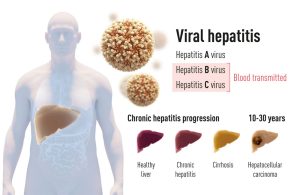Our liver can also be threatened by pathogens. Its precursor, inflammation of the liver (hepatitis), is caused by viruses in about a third of cases. These can be, for example, the hepatitis viruses of the same name, but also the yellow fever virus and circoviruses.
Why does jaundice cause the skin to change color?
The best-known symptom of viral liver inflammation, cirrhosis or other liver disease is jaundice. Colloquially, this is often equated with hepatitis, but jaundice can actually have other causes, such as inflammation of the bile ducts or a blood disorder. It is typical for yellowing of the skin, mucous membranes and dermis of the eyes and internal organs.
The yellow color occurs when bilirubin builds up in the tissues. This dye is a natural breakdown product of the red dye hemoglobin from red blood cells. If the liver does not function properly, it cannot break down the bilirubin that is produced when the red blood cells are broken down as usual and dispose of it in urine and stool. As a result, the dye is distributed throughout the body with the blood and is deposited; Instead, the urine becomes darker and the stool becomes lighter.

The ABC of hepatitis viruses
There are currently five known hepatitis viruses, designated by the letters A to E. They can cause inflammation of the liver of varying severity, some of which can be treated very well and some of which can hardly be treated. Transmission usually occurs through contact with infected blood, sometimes through contaminated food or during sexual intercourse. The five viruses also differ in their area of distribution.
Hepatitis B and C are the most common of the five pathogens. According to the World Health Organization (WHO), more than 350 million people live with a chronic infection caused by hepatitis B or C. Over a million people die from it every year – more than from tuberculosis, AIDS or malaria. Viral hepatitis is one of the most common and deadliest infectious diseases worldwide.
Hepatitis C and B
Around 100 million people worldwide are infected with the hepatitis C virus (HCV) alone. These viruses reproduce particularly well in liver cells. Around 70 million, or well over half, of those infected subsequently develop chronic liver inflammation, which is difficult to treat. This can often be symptom-free and hardly noticed by those affected. However, in around 20 percent of chronic cases, cirrhosis occurs and in one to five percent of cases, the liver is damaged to such an extent that the infected person needs a liver transplant in order not to die. There is currently no vaccine or other preventive measure against hepatitis C, but researchers are working on it.
It is estimated that around 500,000 to 650,000 people in Germany are infected with the highly contagious hepatitis B virus (HBV), although the number of unreported cases is high. According to the WHO, two billion people worldwide could be affected by it, or at least around 300 million – often without knowing it. This infection is significantly more common than that with HCV, but less often leads to chronic liver damage. It is treacherous because, like HCV, it usually progresses slowly and the classic jaundice does not occur. There is no cure for hepatitis B, but it can be treated very well or prevented with a vaccination.

Liver cancer caused by hepatitis viruses
Liver inflammation resulting from infection with hepatitis viruses B and C is also a common cause of liver cancer. This disease is particularly severe when the liver cells are infected with both viruses, which occurs in around 20 percent of those infected. During such an infection, the liver cells release increased amounts of messenger substances from the group of lymphotoxins, which promote tumor development, as researchers have found. “Our results show that increased lymphotoxin production in the liver contributes significantly to chronic liver inflammation and the resulting cancer formation,” said Mathias Heikenwälder from the University of Zurich.
Other hepatitis viruses
Hepatitis Delta can only occur as a co-infection with hepatitis B, since the hepatitis D virus (HDV) needs the envelope of the HB virus to infect the liver cells. How common it is, what damage it causes and whether it can be treated has not been well studied. The same applies to hepatitis E.
Hepatitis A (HAV) affects 1.4 million people worldwide every year, primarily through contaminated water and food. However, this infection usually does not need to be treated because the symptoms such as fever and diarrhea usually go away on their own. In children it is usually symptom-free. Liver failure caused by HAV only occurs very rarely. A vaccine is available and can prevent the disease.
Circoviruses – new pathogen discovered
It was only at the beginning of 2023 that researchers discovered another viral pathogen that causes liver diseases such as hepatitis in a young patient. The species named “human circovirus-1”, or HCirV-1 for short, is one of the circoviruses with circular DNA. This group of viruses is known to cause diseases in birds and pigs, but was previously considered harmless to us humans.
“We suspect that HCirV-1 is of animal origin, but may have been transmitted through a food, similar to the hepatitis E virus,” reported the team led by Philippe Pérot from the Institut Pasteur in Paris. It is still unclear whether this pathogen can also be transmitted from person to person. However, the discoverers assume that the new virus could also be responsible for as yet unexplained cases of hepatitis in other patients.
When harmless viruses suddenly become dangerous
A mysterious hepatitis epidemic in Europe recently caused a stir, affecting hundreds of children at the beginning of 2022. In the spring and summer of 2020, an unusually large number of children in Europe and North America also fell ill with liver inflammation. The livers of small children in particular were often so severely inflamed that they had to be treated in hospital, as the European Center for Disease Prevention and Control (ECDC) reported. However, none of the known triggers could be discovered in the children. The authorities discussed an infection with adenoviruses as a possible alternative cause.
At the beginning of 2023, three research groups discovered that the affected children were actually infected with such a common virus, the adeno-associated virus AAV2. “We were surprised that the mysterious infections were not caused by an unknown, newly emerged virus, but apparently by pathogens that are common in children,” says Charles Chiu from the University of California in San Francisco. But in combination with other viruses and the children’s immune systems, which were weakened by the lockdowns, this otherwise harmless cold virus could actually have caused the severe liver inflammation, the researchers concluded.

Yellow fever and parasites
The yellow fever virus, which occurs primarily in South America and Africa, can also affect the liver. It is a flavivirus and is transmitted primarily by the yellow fever mosquito Aedes aegypti. Most infected people only suffer from fever, nausea and pain for a few days and recover on their own. However, around one in six people experience mild jaundice, internal bleeding and high fever as a result of the infection, hence the somewhat misleading name yellow fever. The WHO estimates that around 200,000 people get yellow fever every year and around 60,000 die from it. However, a yellow fever vaccination can prevent the infection.
In addition to viruses, our liver can also be damaged by parasites in rare cases. These include the fox tapeworm and dog tapeworm, which can form spongy tissue in our liver. Like tumors, these growths often go unnoticed for years. Sometimes they cause jaundice. “The parasite eggs can be transmitted to us humans by foxes, dogs or cats. However, the exact route of transmission is unknown,” said the BDI.
January 12, 2024 – Claudia Krapp

